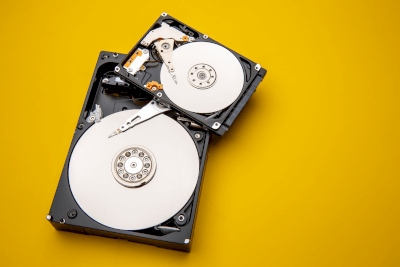What Are Hard Disk Drives?

Hard Disk Drives (HDDs) are typical external storage devices. It is a non-volatile storage device that retains data even when the power is turned off.
The structure consists of multiple metal disks with magnetic materials stacked on top of each other. Data is read and written by rotating the disks at high speed and magnetizing the magnetic material by bringing a magnetic head close to it.
Since the magnetic head and disk are brought into close proximity when reading and writing data, the structure is vulnerable to vibration. Because of the large amount of data handled, high-speed
communication is required for the connection, and standards such as SCSI, IDE, and SATA are used. In the past, cables using SCSI and SATA standards were often used to connect external HDDs.
However, in recent years, as data transfer speeds have increased through USB connections, USB is increasingly being used to connect external HDDs.
Usage of Hard Disk Drives
Hard Disk Drives are often used as mass storage devices to store data on PCs. In addition to PCs, hard disks are also widely used in electronic devices such as external storage devices, servers, network drives, hard disk recorders in home appliances, and game consoles.
In recent years, as the capacity of SSDs have increased, they are increasingly taking on the role traditionally played by hard disk drives: HDDs use magnetic disks, while SSDs record data in NAND flash memory, which uses semiconductor elements.
The advantage of hard disk drives over SSDs is that large capacities can be procured at low cost. For this reason, SSDs are increasingly being used as storage devices for frequent read/write operations, while hard disk drives are being used as secondary data storage devices.
Principle of Hard Disk Drives
A hard disk generally consists of a disk, motor, magnetic head, and control circuit.
In a hard disk, a single disk is called a platter. The surface of the platter is coated with magnetic material, which is used to magnetically record data. In order to obtain the data capacity, multiple platters are generally stacked on top of each other.
Hard disks are equipped with motors to operate them. There are two types of motors: one is the motor that spins the platters. This is called a spindle motor. The faster this motor can rotate, the faster data can be read and written, so the number of revolutions is sometimes used as a performance indicator.
The other motor drives the arm that moves the magnetic head. The magnetic head is what reads and writes the data on the platters in a hard disk. Since there are multiple platters, magnetic heads are mounted according to the number of platters. The principle of writing data is to apply a magnetic force to the magnetic material on the platter surface using an electric current.
Which direction the magnetic force (the direction of the S and N poles of the magnet) is facing corresponds to the 0 and 1 information in the digital record. When reading, data is read based on the resistance value that changes under the influence of the magnetic field on the platters.
How to Select Hard Disk Drive
There are different points of focus for selecting an internal hard disk drive and an external HDD.
1. Internal Hard Disk Drive
You may purchase an internal hard disk drive to build your own computer or to improve the performance of your desktop computer.
First, check the connection standard (IDE or SATA) of the environment in which you intend to build or replace the HDD, and choose one that fits.
Next, choose a disk size between 3.5″ and 2.5″. 3.5″ is generally for standard desktop PCs, while 2.5″ is for notebook PCs or space-saving desktop PCs. A 2.5″ disk can also be installed by installing a mounter in the 3.5″ space of a desktop PC.
Select the capacity that best suits the intended use. Unnecessarily large capacities will increase the cost.
The most common disk rotation speeds are 7,200 rpm and 5,400 rpm. The higher the speed, the faster data can be read and written, but it is also more expensive and generates more heat. It is advisable to select a disk drive based on the application and whether or not high speed read/write speed is required.
2. External Hard Disk Drive
There are two types of external hard disk drives: stationary and portable. The stationary type is heavy and not suitable for carrying around, but inexpensive, while the portable type is lightweight and is designed to protect against shocks while being carried around.
The interface to be connected to an external hard disk drive is selected based on the device to be connected. Connection standards include USB, Thunderbolt, and eSATA, etc. Since the transmission speed of USB, etc. varies greatly from generation to generation, it is advisable to confirm the use in detail and select one that supports the expected transmission speed.